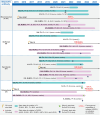CD20×CD3 Bispecific Antibodies in B-NHL: A Review of Translational Science, Pharmacokinetics, Pharmacodynamics, and Dose Strategy in Clinical Research
- PMID: 40471801
- PMCID: PMC12139688
- DOI: 10.1111/cts.70250
CD20×CD3 Bispecific Antibodies in B-NHL: A Review of Translational Science, Pharmacokinetics, Pharmacodynamics, and Dose Strategy in Clinical Research
Abstract
Despite advancements in treatment for B-cell non-Hodgkin lymphoma (B-NHL) in recent decades, many patients still relapse or are refractory to treatment, which represents a high unmet medical need. Novel CD20 × CD3 T-cell-engaging bispecific antibodies (bsAbs) have created a new paradigm for the treatment of B-NHL. Pivotal studies of four CD20 × CD3 bsAbs, mosunetuzumab, glofitamab, epcoritamab, and odronextamab, as monotherapy, have demonstrated robust responses with generally manageable safety profiles in patients with relapsed or refractory follicular lymphoma and diffuse large B-cell lymphoma after ≥ 2 lines of systemic therapy. These agents have presented unique challenges (e.g., cytokine release syndrome [CRS]), which have required different strategies to overcome. This review provides a comprehensive overview of the clinical development of these four CD20 × CD3 bsAbs that have been investigated for the treatment of B-NHL, with a specific focus on translational assessments to select starting doses in first-in-human studies, management of CRS, application of modeling and simulation approaches to aid dose escalation and optimization/selection, and strategies used in the design of phase I-III clinical trials. By highlighting learnings and experiences from these four bsAbs assessed, which have not been summarized collectively elsewhere, we aim to promote more efficient study design for novel bsAbs in B-NHL in the future.
Keywords: clinical trials; dose; drug development; exposure response; hematology; model‐based drug development; monoclonal antibodies; oncology; pharmacodynamics; pharmacokinetics.
© 2025 Regeneron Pharmaceuticals. Clinical and Translational Science published by Wiley Periodicals LLC on behalf of American Society for Clinical Pharmacology and Therapeutics.
Conflict of interest statement
M.Z., X.G., S.G., and J.D.D. hold stock or stock options for and are employees of Regeneron Pharmaceuticals, Inc. E.W. is an employee of Orion Pharma/Orion Corporation, and an equity holder in and former employee of Regeneron Pharmaceuticals, Inc.
Figures

Similar articles
-
Glofitamab, a Novel, Bivalent CD20-Targeting T-Cell-Engaging Bispecific Antibody, Induces Durable Complete Remissions in Relapsed or Refractory B-Cell Lymphoma: A Phase I Trial.J Clin Oncol. 2021 Jun 20;39(18):1959-1970. doi: 10.1200/JCO.20.03175. Epub 2021 Mar 19. J Clin Oncol. 2021. PMID: 33739857 Free PMC article. Clinical Trial.
-
An evaluation of odronextamab for the treatment of multiple subtypes of relapsed/refractory B-cell non-Hodgkin lymphoma.Expert Opin Biol Ther. 2025 Apr;25(4):331-343. doi: 10.1080/14712598.2025.2479631. Epub 2025 Mar 24. Expert Opin Biol Ther. 2025. PMID: 40106587 Review.
-
CD20 × CD3 bispecific antibodies for lymphoma therapy: latest updates from ASCO 2023 annual meeting.J Hematol Oncol. 2023 Aug 3;16(1):90. doi: 10.1186/s13045-023-01488-4. J Hematol Oncol. 2023. PMID: 37537626 Free PMC article.
-
Bispecific Antibodies for Non-Hodgkin Lymphoma Treatment.Curr Treat Options Oncol. 2022 Feb;23(2):155-170. doi: 10.1007/s11864-021-00925-1. Epub 2022 Feb 19. Curr Treat Options Oncol. 2022. PMID: 35182296 Review.
-
Odronextamab, a human CD20×CD3 bispecific antibody in patients with CD20-positive B-cell malignancies (ELM-1): results from the relapsed or refractory non-Hodgkin lymphoma cohort in a single-arm, multicentre, phase 1 trial.Lancet Haematol. 2022 May;9(5):e327-e339. doi: 10.1016/S2352-3026(22)00072-2. Epub 2022 Apr 1. Lancet Haematol. 2022. PMID: 35366963 Free PMC article. Clinical Trial.
References
-
- Sung H., Ferlay J., Siegel R. L., et al., “Global Cancer Statistics 2020: GLOBOCAN Estimates of Incidence and Mortality Worldwide for 36 Cancers in 185 Countries,” CA: A Cancer Journal for Clinicians 71, no. 3 (2021): 209–249. - PubMed
-
- Leukemia & Lymphoma Society , “NHL Subtypes,” https://www.lls.org/lymphoma/non‐hodgkin‐lymphoma/nhl‐subtypes.
Publication types
MeSH terms
Substances
LinkOut - more resources
Full Text Sources

